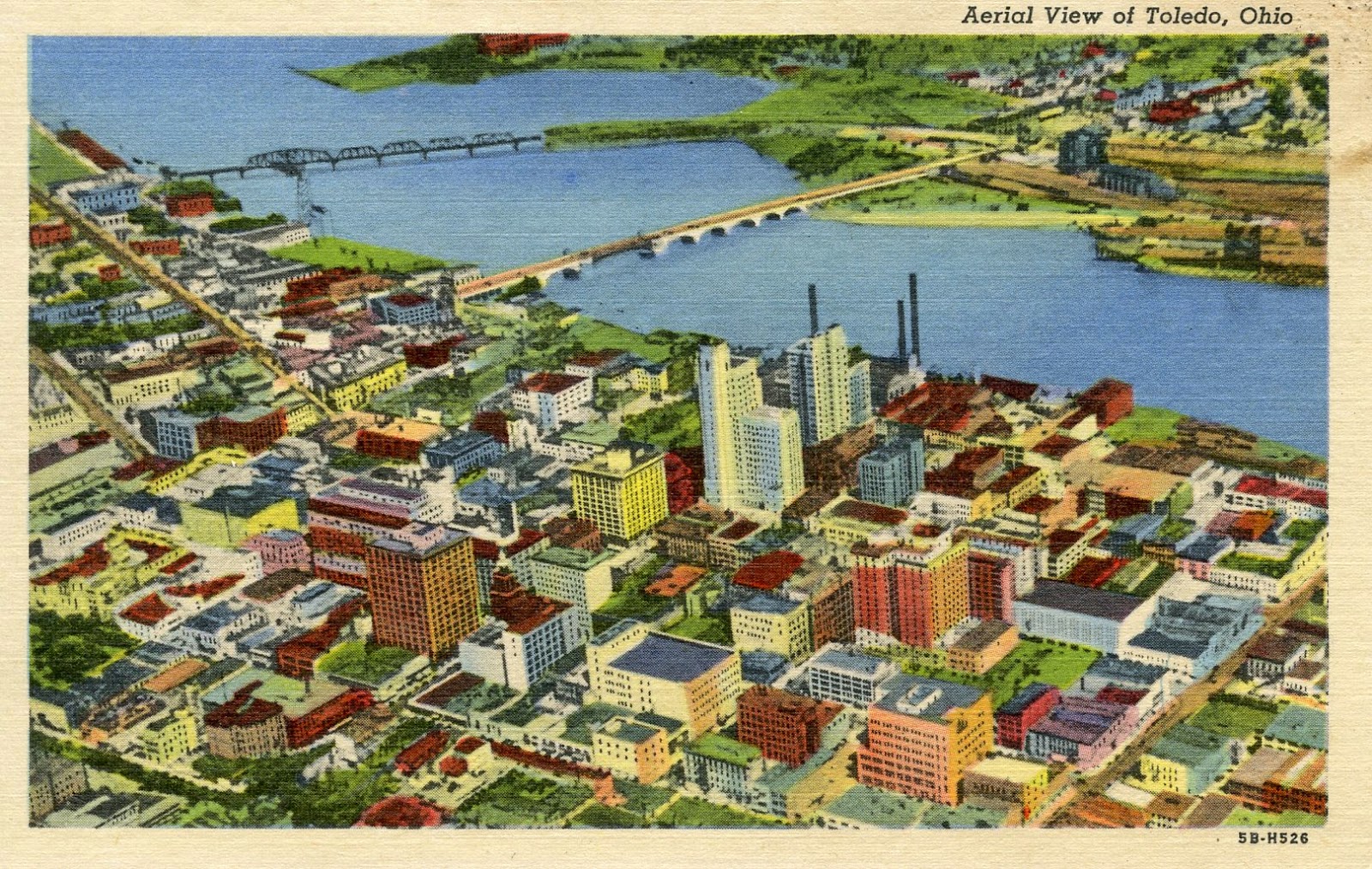And does anybody in Ohio
Dream of that Spanish citadel?
Toledo, Ohio was founded in 1833 when two existing towns – Port Lawrence and Vistula – merged.
 |
| Toledo, Ohio in 1945 |
It's not clear why the residents of the new city chose to name it after the ancient Spanish city of Toledo. One story is that Washington Irving, who spent several years researching and writing in Spain, suggested the name to his brother, who was a resident of the Ohio Toledo.
Another legend is that the name was suggested by Two Stickney, who caused the only casualty of the "Toledo War" – an otherwise bloodless border dispute between Ohio and Michigan – when he stabbed a Michigan deputy sheriff who was attempting to arrest One Stickney, Two's older brother.
(The brothers' father, Benjamin Franklin Stickney – named after his famous great-uncle – said that he named his sons One and Two so they could pick their own names when they grew up, but they stuck with One and Two instead. You can click here if you'd like to read more about the eccentric Benjamin Franklin Stickney.)
 |
| Two Stickney, hero of the Toledo War |
Yet another story gives credit for the choice of Toledo to a local merchant who said the name "is easy to pronounce, is pleasant in sound, and there is no other city of that name on the American continent."
* * * * *
The original Toledo is an ancient Spanish city with a rich cultural and architectural heritage. Our featured song accurately describes the Spanish Toledo as a "citadel" – the old part of the city is located on a mountaintop overlooking the Tagus River, the longest river on the Iberian Peninsula.
One of Toledo's most famous residents was the artist Doménikos Theotokópoulos, who is better known by his nickname – El Greco ("the Greek").
 |
| A presumed self-portrait by El Greco |
El Greco was born in 1541 on the Greek island of Crete, which then belonged to the Republic of Venice. After learning to paint in Crete, he moved to Venice and then to Rome, where he opened a workshop. In 1577, he moved to Madrid and then on to Toledo, where he lived until his death in 1614.
* * * * *
The National Gallery of Art in Washington, DC, has seven paintings by El Greco. I recently attended the press preview of a new NGA exhibition marking the 400th anniversary of El Greco's death that features his NGA paintings along with several others from other Washington and Baltimore museums.
Here's Saint Martin and the Beggar:
Here's Saint Martin and the Beggar:
 |
| National Gallery of Art |
And here's Madonna and Child with Saint Martina and Saint Agnes:
Those two paintings, both of which are in the NGA's permanent collection, once hung opposite one another, flanking the central altar in the Chapel of Saint Joseph in Toledo, Spain.
Perhaps the most interesting of the eleven works in the exhibition is Laocoön, the only surviving El Greco painting with a mythological subject:
 |
| National Gallery of Art |
* * * * *
Perhaps the most interesting of the eleven works in the exhibition is Laocoön, the only surviving El Greco painting with a mythological subject:
 |
| National Gallery of Art |
Laocoön was a Trojan priest who warned his countrymen to beware of the Trojan Horse. In the Aeneid, Virgil has Laocoön say these words:
Do not trust the horse, Trojans
Whatever it is, I fear the Greeks even bearing gifts
But Laocoön was punished by a Greek-friendly god -- Athena, Poseidon, or Apollo, depending on the teller of the story -- for his attempt to defeat the Greek subterfuge. Giant sea serpents slithered up from the sea and strangled Laocoön and his two sons.
According to one source, however, Laocoön was actually punished for having sex with his wife on holy ground sacred to the gods.
In any event, Laocoön's warning wasn't heeded and the Greeks' sneak attack on Troy was successful.
Art historians believe that El Greco's painting was inspired by this ancient sculpture of Laocoön and his sons, which was excavated in Rome 1506 and is now on display in one of the Vatican museums:
* * * * *
El Greco's Laocoön sets the scene outside the gates of Toledo. Toledo is featured in a number of El Greco's paintings, including several that depict Biblical scenes that took place far away from Spain.
El Greco's only two surviving landscapes both depict Toledo. "View of Toledo," which is owned by the Metropolitan Museum of Art in New York City, is a dramatic painting that takes some liberties with the actual configuration of the city's buildings:
The National Gallery of Art's El Greco exhibition can be viewed in the NGA's West Building through February 16, 2015. Click here to learn more.
"Toledo" is from the 1998 album Painted from Memory, which features a dozen songs co-written by Elvis Costello and Burt Bacharach.
"Toledo" is from the 1998 album Painted from Memory, which features a dozen songs co-written by Elvis Costello and Burt Bacharach.
Click here to see a video of a live performance of "Toledo."
Click below to buy the version of the song that appeared on Bill Frisell's 1999 album, The Sweetest Punch, which consists of jazz arrangements of the Painted from Memory songs. Most of the tracks on that album are instrumentals, but Costello did sing on "Toledo."






What an informative, lovely post! I'm so lucky to have surfed in. I'm a Costello fan who's loved "Toledo" and Painted from Memory since they were released, and I was aimlessly drifting about when a benevolent wave tossed me ashore here.
ReplyDeleteMy first visit to your blog was a great treat! I'll certainly return.
Thanks,
Stuart Gardner